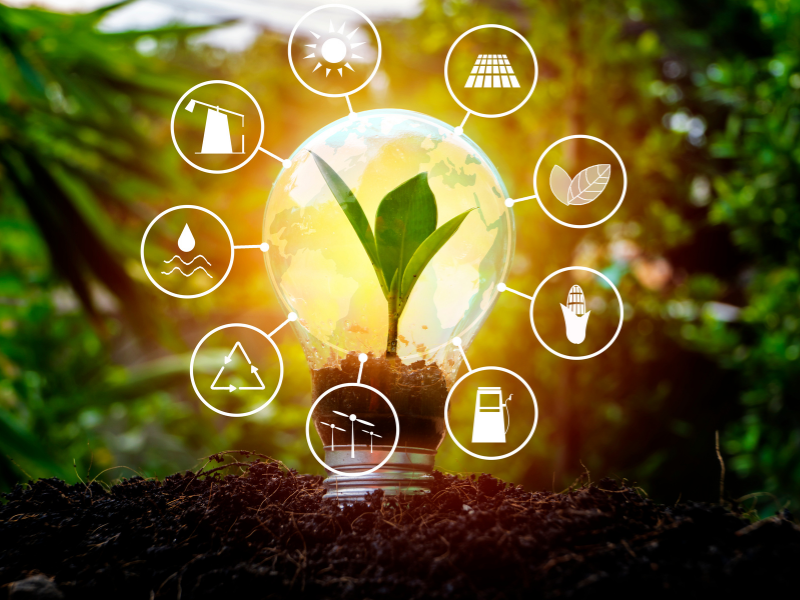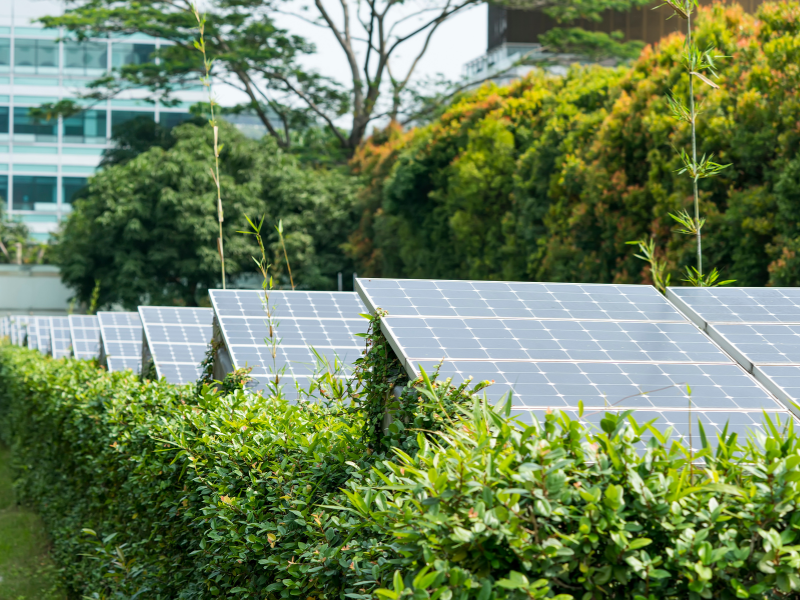As the world grapples with the urgent need for sustainable solutions, renewable energy technologies have emerged as an increasingly viable and promising option. A shift towards these clean and renewable energy sources not only mitigates the environmental impact of traditional energy systems but also offers numerous economic and social benefits. In this comprehensive guide, we will delve into the various renewable energy technologies, explore their advantages and limitations, and delve into the future prospects of a renewable energy-driven world.
What are Renewable Energy Technologies?

Renewable energy technologies are a diverse range of methods used to generate electricity and heat from naturally replenishing sources. Unlike fossil fuels, which are finite and contribute to climate change, renewable energy technologies harness renewable resources such as sunlight, wind, water, geothermal heat, biomass, and the ocean’s energy. These technologies encompass various forms of power generation, energy storage, and conversion mechanisms.
Solar Power: Harnessing the Sun’s Energy
Solar power is a sustainable and abundant source of energy, capable of providing clean electricity through the photovoltaic (PV) effect. By using solar panels, sunlight is converted into electrical energy through the movement of electrons in a semiconductor material. This process, known as the photovoltaic effect, allows for the direct conversion of sunlight into usable electricity. Solar power has gained significant momentum in recent years, with advancements in technology and reductions in costs making it an increasingly viable option for residential, commercial, and utility-scale applications.
Wind Power: Capturing Nature’s Force
Wind power harnesses the kinetic energy of the wind to generate electricity. Wind turbines, consisting of large blades mounted on a tower, capture the wind’s energy and convert it into rotational motion. This motion is then used to drive an electrical generator, producing clean and renewable electricity. With its ability to scale from small, decentralized applications to large, utility-scale installations, wind power has become one of the fastest-growing renewable energy technologies worldwide.
Hydropower: Leveraging the Power of Water
Hydropower harnesses the gravitational force of falling or flowing water to generate electricity. By directing water through turbines, the kinetic energy of the moving water is converted into mechanical energy and then into electrical energy. Hydropower offers a reliable and flexible solution for generating clean electricity, with a wide range of applications ranging from large-scale hydroelectric dams to micro-hydropower systems.
Geothermal Energy: Tapping into Earth’s Heat
Geothermal energy utilizes the heat stored in the Earth’s crust to generate electricity and heat. This renewable energy technology taps into the natural heat reservoirs beneath the Earth’s surface and converts it into usable energy. Geothermal power plants extract the hot water or steam from geothermal reservoirs and utilize it to drive turbines, producing electricity. Geothermal energy is highly reliable and can be harnessed year-round, making it a valuable asset in the transition to a sustainable energy future.
Biomass Energy: From Waste to Renewable Fuel
Biomass energy harnesses organic matter such as plant material, agricultural residues, and even municipal solid waste to produce heat, electricity, and biofuels. Biomass can be combusted to generate heat directly or converted into biogas or biofuels through processes like anaerobic digestion or biomass gasification. This renewable energy technology holds significant potential for reducing greenhouse gas emissions and diversifying energy sources.
Ocean Energy: Extracting Power from the Sea
Ocean energy encompasses various technologies that harness the immense power of tides, waves, and temperature differences in the ocean to generate electricity. Tidal energy utilizes the gravitational forces of the moon and sun to generate electricity, while wave energy harnesses the kinetic energy of ocean waves. Additionally, ocean thermal energy conversion (OTEC) leverages temperature differences between the surface and deep waters to generate electricity.
Advantages of Renewable Energy Technologies

Renewable energy technologies offer numerous advantages over conventional energy sources. Firstly, they provide a sustainable and environmentally friendly alternative to fossil fuels, reducing greenhouse gas emissions and mitigating climate change. Additionally, renewable energy sources are virtually inexhaustible, ensuring long-term energy security. Furthermore, they often require less maintenance and offer cost savings in the long run, contributing to economic growth. Moreover, renewable energy technologies promote decentralization, enabling communities to become self-sufficient and resilient. Lastly, these technologies create new job opportunities, stimulate innovation, and foster social and economic development.
Limitations and Challenges of Renewable Energy Technologies

Although renewable energy technologies hold great promise, they also face certain limitations and challenges. Intermittency, the reliance on weather conditions, and the need for energy storage solutions pose significant hurdles to achieving a consistent and reliable energy supply. Additionally, high upfront costs, limited infrastructure, and geographical constraints can impede the widespread adoption of these technologies. Furthermore, some renewable energy technologies, such as hydropower and bioenergy, may have environmental and social impacts that need to be carefully managed. Overcoming these challenges requires technological advancements, policy support, and widespread public awareness.
Renewable Energy Technologies in Action: Real-Life Examples

Various countries and regions have successfully embraced renewable energy technologies, leading the way towards a sustainable future. For instance, Germany has demonstrated remarkable success in integrating solar and wind power into their energy mix, partially attributed to their supportive policies and incentives. Costa Rica has achieved nearly 100% renewable electricity generation in recent years, primarily relying on hydropower and geothermal energy. Furthermore, the small island nation of Denmark has transformed its energy landscape through wind power, with wind turbines providing a significant portion of its electricity needs.
The Future of Renewable Energy Technologies
The future of renewable energy technologies looks exceptionally promising. With ongoing technological advancements, decreasing costs, and increasing efficiency, these clean energy options are becoming increasingly competitive with traditional energy sources. The integration of energy storage solutions, such as advanced batteries, pumped hydro storage, and hydrogen fuel cells, will further enhance the reliability and grid integration of renewable energy technologies. Moreover, the rise of smart grids, energy management systems, and digitalization will optimize energy consumption and maximize the utilization of renewable energy resources.
Role of Policy and Government Support
Government policies and regulations play a crucial role in promoting the widespread adoption of renewable energy technologies. Incentives, feed-in tariffs, tax credits, and renewable portfolio standards incentivize individuals, businesses, and utilities to invest in clean energy solutions. Moreover, research funding, technology development programs, and public-private partnerships facilitate innovation and drive technological advancements in renewable energy. Strong political will, international cooperation, and long-term policy stability are essential to creating an enabling environment for a renewable energy-powered future.
The Economics of Renewable Energy Technologies
The economics of renewable energy technologies have seen significant improvements in recent years. The falling costs of solar panels, wind turbines, and energy storage systems have made these technologies increasingly cost-competitive with traditional energy sources. In some cases, renewables have even become the lowest-cost option for new electricity generation. The transition to renewable energy creates economic opportunities by stimulating job growth across various sectors such as manufacturing, installation, maintenance, and research. Furthermore, renewable energy investments attract private capital, drive technological innovation, and contribute to sustainable economic development.
Energy Storage Solutions for Renewable Energy Technologies
Energy storage solutions are vital for ensuring the reliability and stability of renewable energy systems. Advancements in battery technologies, such as lithium-ion batteries, have revolutionized the storage landscape, enabling the smooth integration of intermittent renewable energy sources. Pumped hydro storage, compressed air energy storage, and thermal energy storage systems also play a crucial role in balancing electricity supply and demand. The development of cost-effective, efficient, and scalable energy storage solutions is essential for maximizing the value and potential of renewable energy technologies.
Integration of Renewable Energy Technologies into the Electricity Grid
The integration of renewable energy technologies into the electricity grid requires careful planning and coordination. As renewable energy sources are intermittent, grid operators need to manage fluctuations in supply and demand effectively. Smart grids, advanced energy management systems, and demand-response technologies enable the smooth integration of renewable energy into the existing grid infrastructure. Moreover, interconnection and transmission infrastructure improvements facilitate the transfer of renewable energy from resource-rich areas to population centers. Grid flexibility, resilience, and a holistic approach to energy planning are crucial for achieving a reliable and sustainable energy future.
Renewable Energy Technologies and Job Creation
The adoption of renewable energy technologies brings forth significant job creation opportunities. The renewable energy sector employs a wide range of professionals, from engineers and technicians to project managers and policymakers. Furthermore, the deployment of renewable energy systems stimulates job growth in related industries such as manufacturing, construction, and maintenance. According to the International Renewable Energy Agency (IRENA), the renewable energy sector employed over 11 million people worldwide in 2019, with the potential to generate millions more jobs in the coming years.
Environmental Impacts and Sustainability of Renewable Energy Technologies
Renewable energy technologies offer considerable environmental benefits compared to traditional energy sources. They produce little to no greenhouse gas emissions, helping to mitigate climate change and reduce air pollution. However, these technologies are not entirely free from environmental impacts. Hydropower projects, for example, can disrupt ecosystems and affect aquatic biodiversity. Biomass energy may require careful management to avoid negative impacts on forests and land use. It is crucial to adopt sustainable practices and conduct effective environmental assessments to minimize the ecological footprint of renewable energy technologies throughout their life cycles.
Social and Community Benefits of Adopting Renewable Energy Technologies
The widespread adoption of renewable energy technologies brings significant social and community benefits. Firstly, it improves energy access, particularly in remote and underserved areas, empowering communities and alleviating energy poverty. Moreover, renewable energy investments foster local economic development by creating jobs, stimulating local businesses, and attracting investments. In addition, decentralized renewable energy systems enable energy self-sufficiency, enhancing energy security and resilience. Finally, the transition to renewables is often accompanied by educational and capacity-building initiatives, creating opportunities for knowledge transfer and empowering individuals and communities.
Technological Innovations and Breakthroughs
Technological innovations and breakthroughs are driving the rapid evolution and deployment of renewable energy technologies. Advances in materials science, such as improvements in solar panel efficiency and longevity, are enhancing the economic viability of solar power. The development of next-generation wind turbine technologies, including larger rotor diameters and advanced control systems, is increasing the efficiency and cost-effectiveness of wind power. Breakthroughs in energy storage solutions, such as solid-state batteries and flow batteries, are revolutionizing the renewable energy landscape. These advancements pave the way for a more sustainable and renewable future.
Overcoming Barriers: Education and Awareness
Education and awareness play a crucial role in overcoming barriers to the adoption of renewable energy technologies. By educating individuals, communities, policymakers, and businesses about the benefits and potential of renewable energy, barriers such as misinformation, skepticism, and resistance can be overcome. Outreach programs, public campaigns, and educational initiatives raise awareness about the urgency of transitioning to renewable energy and empower individuals to take action. Promoting renewable energy literacy and creating platforms for knowledge sharing are essential for driving widespread acceptance and accelerating the transition to a sustainable energy future.
International Cooperation for a Renewable Energy Future
The transition to a renewable energy future requires robust international cooperation and collaboration. Global partnerships, such as the Paris Agreement, facilitate the exchange of knowledge, technology transfer, and financial support for developing countries. International organizations, such as the United Nations and the International Renewable Energy Agency, provide platforms for multilateral dialogue and coordination. Sharing best practices, experiences, and lessons learned across borders fosters innovation, accelerates the deployment of renewable energy technologies, and ensures a fair and equitable transition for all nations.
Challenges and Opportunities in Developing Countries
Developing countries face unique challenges and opportunities in adopting renewable energy technologies. Limited access to financing, insufficient infrastructure, and the absence of supportive policies can impede the widespread deployment of these technologies. However, developing countries also possess significant renewable energy resources, offering immense potential for leapfrogging traditional energy systems and embracing sustainable alternatives. By leveraging innovative financing mechanisms, technological partnerships, and capacity-building initiatives, developing countries can overcome challenges and harness the benefits of renewable energy technologies for economic growth, poverty alleviation, and sustainable development.
Investing in Renewable Energy Technologies
Investing in renewable energy technologies presents a compelling opportunity for individuals, businesses, and institutions. Renewable energy investments have consistently delivered stable financial returns and offer diversification benefits. Additionally, they align with environmental, social, and governance (ESG) criteria, enabling investors to contribute to a sustainable future. Various financing avenues, such as green bonds, impact investing, and venture capital, provide opportunities for individuals and institutions to channel their capital towards renewable energy projects. By investing in renewable energy technologies, stakeholders participate in the global energy transition and contribute to a cleaner and more sustainable planet.
Overcoming the Cost Barrier: Financing and Incentives
While the costs of renewable energy technologies have declined significantly, financing and incentives play a crucial role in overcoming the remaining cost barrier. Government incentives, such as tax credits, grants, and subsidies, reduce the upfront costs and financial risks associated with renewable energy investments. Additionally, innovative financing mechanisms, including power purchase agreements (PPAs), feed-in tariffs (FITs), and green loans, facilitate the deployment of renewable energy projects by ensuring a stable revenue stream for energy producers. By combining financial incentives and innovative financing models, the affordability and accessibility of renewable energy technologies can be further enhanced.
Conclusion
Renewable energy technologies represent a promising pathway towards a sustainable and resilient energy future. Solar power, wind power, hydropower, geothermal energy, biomass energy, and ocean energy offer viable alternatives to traditional fossil fuel-based energy systems. By harnessing the power of nature, we can reduce greenhouse gas emissions, mitigate climate change, and create a cleaner and greener planet. The advantages of renewable energy technologies, such as sustainability, energy security, job creation, and community empowerment, are too significant to be ignored. With the right policies, investments, and public support, we can rapidly shift towards a renewable energy-driven world, ensuring a brighter future for generations to come. So let’s embrace renewable energy technologies and pave the way for a sustainable and prosperous planet.

